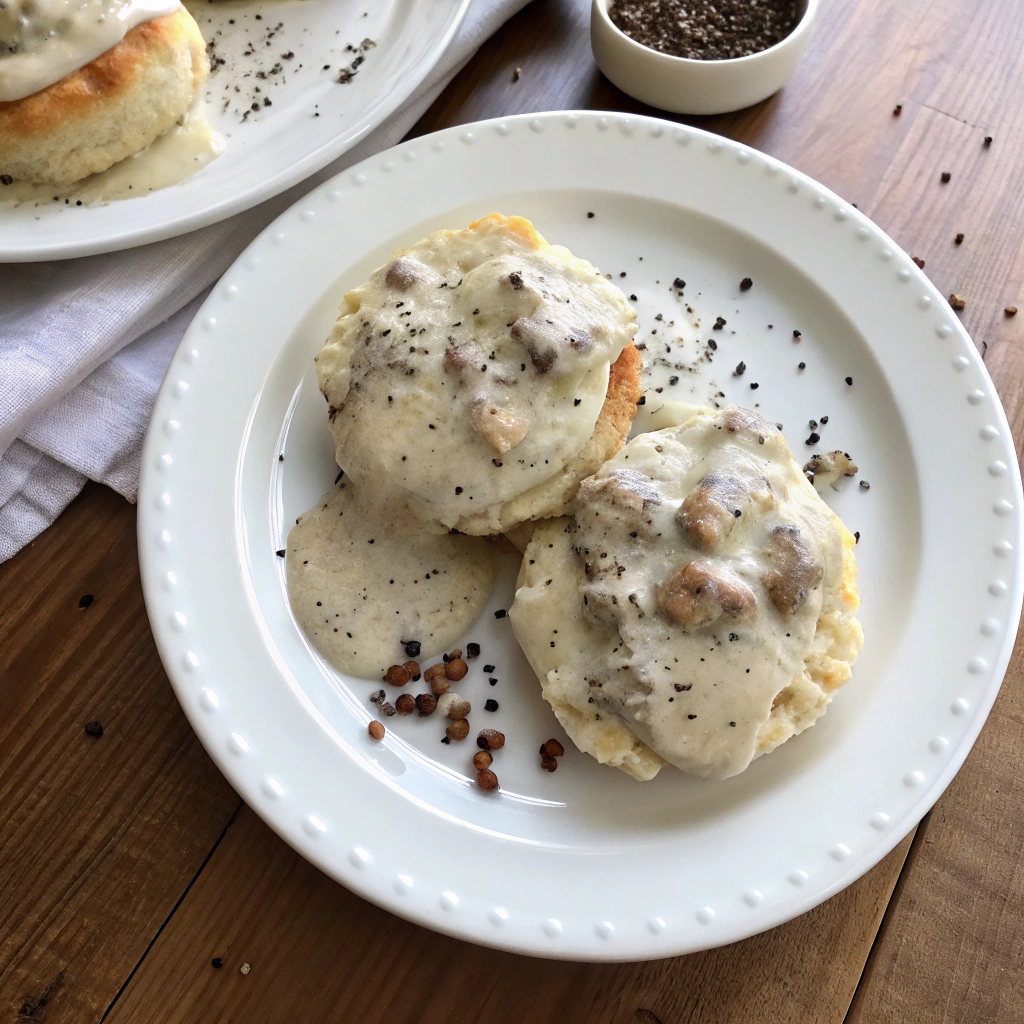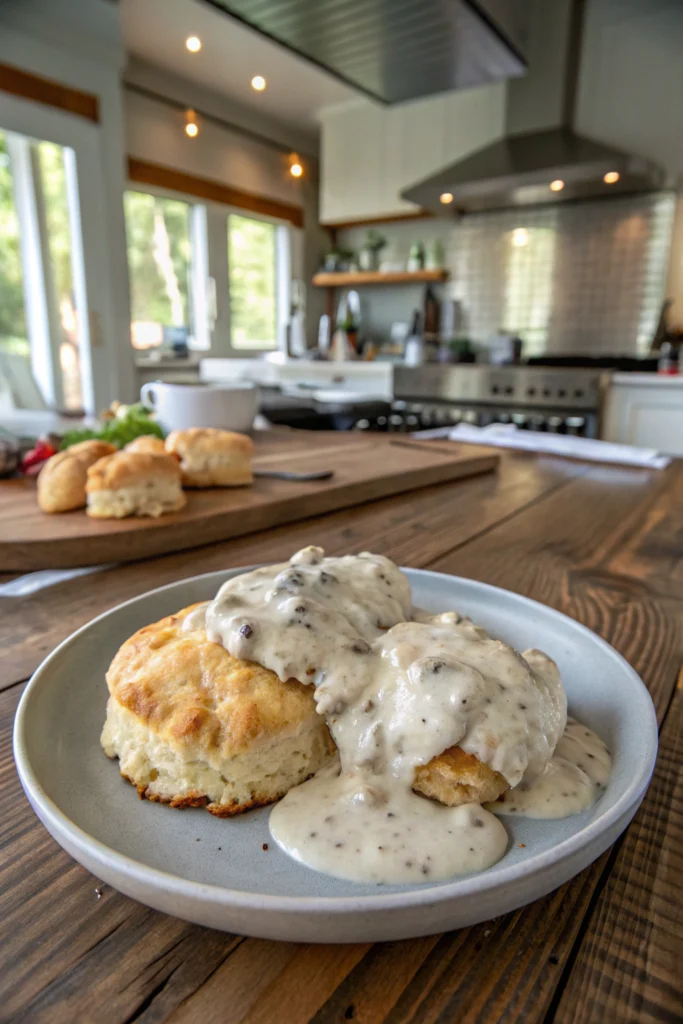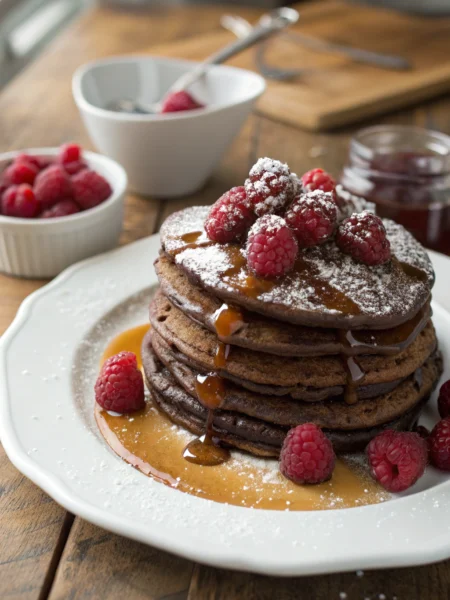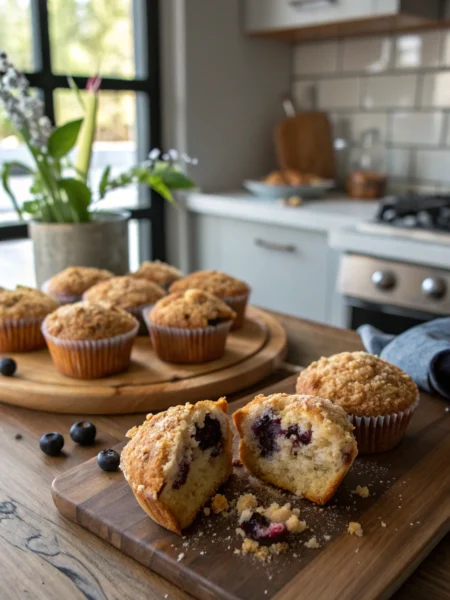Y’all, let me tell you about my lifelong love affair with biscuits and gravy, the ultimate Southern comfort food. Growing up in Tennessee, Sunday mornings meant waking up to the smell of butter-brushed biscuits baking and my mama’s spicy sausage gravy bubbling on the stove. I’ve spent years perfecting my own version of this classic biscuits and gravy recipe, and boy, have there been some interesting mishaps along the way! (Like that time I used self-rising flour in the gravy… let’s just say it wasn’t pretty.)
Whether you’re a seasoned Southern cook or trying this classic biscuits and gravy for the first time, I’m here to share everything I know about making this stick-to-your-ribs breakfast favorite. Trust me, once you master this biscuits and gravy recipe, your family will be begging for it every weekend.
The History Behind Classic Biscuits and Gravy
From Pioneer Days to Modern Breakfast Tables
Back in the late 1800s, biscuits and gravy wasn’t the Instagram-worthy comfort food we know today. It was born out of necessity, when Southern pioneers and early settlers had to make do with simple, cheap ingredients. Flour, lard, and milk were staples, and any meat drippings were too precious to waste. My great-grandma used to tell me stories about how her mama would save every bit of grease from cooking – not a drop went to waste!
The gravy helped stretch those meat drippings into a filling meal that could feed a hungry family. Biscuits were the perfect vehicle for sausage gravy because they could be made quickly with just a few pantry ingredients.
Regional Variations Across the South
Spend any time traveling through the South, and you’ll discover that no two families make their biscuits and gravy exactly the same way. In the Carolinas, they often use country ham instead of sausage, creating a saltier, more intense gravy. Down in Louisiana, you might find yours spiced up with cayenne and black pepper – whew, talk about a wake-up call!
My Alabama cousins swear by adding a pinch of sage to their sausage gravy, while some folks in Georgia like theirs with a splash of coffee mixed in. Me? I’m partial to the Tennessee style biscuits and gravy, with plenty of black pepper and extra-fluffy cathead biscuits.
Why Biscuits and Gravy Became a Comfort Food Star
There’s something magical about that first bite of a warm, buttery biscuit smothered in creamy gravy. I remember my grandpa saying, “Ain’t nothing fixes a rough morning like biscuits and gravy.” He wasn’t wrong! This dish stuck around because it’s affordable, filling, and just plain delicious.
During the Great Depression, it kept families going, and today it’s still the go-to cure for everything from hangovers to heartbreak. For a delicious breakfast alternative, try making a Sweet Potato and Egg Skillet – it’s another hearty Southern-inspired morning meal. It’s also incredibly forgiving – even if your biscuits aren’t picture-perfect, they’ll still taste amazing drowning in that peppery gravy. That’s probably why it’s become such a staple at diners and family tables alike. So, what makes the perfect biscuits and gravy so irresistible?
Mastering Perfect Homemade Buttermilk Biscuits
Essential Ingredients for Flaky Biscuits

Let’s talk about what makes biscuits truly amazing – it’s all in the ingredients! I learned this the hard way after countless flat, dense disasters. You’ll need White Lily flour if you can find it (it’s a Southern baker’s secret weapon), but any low-protein flour works well. Fresh buttermilk is non-negotiable – the real stuff, not the milk-and-vinegar substitute. Trust me, I’ve tried both, and there’s just no comparison.
Your baking powder should be fresh – I write the date on mine since old powder equals flat biscuits. A pinch of salt brings out the buttery flavor, and please, skip the margarine! I keep these basics stocked so I can whip up a batch of flaky biscuits whenever my family begs for Sunday breakfast.
The Cold Butter Secret
Here’s the game-changer that took my biscuits from “meh” to “wow”: ice-cold butter, and lots of it! I pop my butter in the freezer for 15 minutes before starting. Why? Those little cold butter pockets create steam while baking, giving you the flakiest layers imaginable.
I grate frozen butter using my box grater’s large holes – it’s so much easier than cutting it in with pastry knives. Quick tip: if your kitchen’s warm, stick your bowl and flour in the fridge too. When I’m working ahead, I’ll mix the dry ingredients and grated butter, then keep it all cold until I’m ready to add buttermilk. Summer baking can be tricky, but cold ingredients make all the difference for perfect biscuits.
Folding Techniques for Sky-High Layers
Ready for the magic that creates those gorgeous, pull-apart layers? After mixing your dough (don’t overwork it!), turn it onto a floured surface and pat it into a rectangle. Now, fold it like a letter – right side in, left side over. Pat it down, rotate a quarter turn, and repeat this process six times.
I learned this folding technique for biscuits from my grandmother, and it’s never failed me. Keep your movements light and quick to keep that butter cold. If the dough feels warm, pop it in the fridge for 15 minutes between folds. When cutting biscuits, use a sharp-edged cutter and push straight down – no twisting, or you’ll seal those beautiful layers!
Creating Rich and Creamy Sausage Gravy
Choosing the Right Sausage for Your Gravy
For the best sausage gravy, start with bulk breakfast sausage – I prefer the sage-seasoned kind for extra flavor. Jimmy Dean is my go-to, but any good-quality brand works well. If you’re feeling fancy, try mixing hot and regular sausage for a nice kick. My local butcher makes an amazing maple breakfast sausage that adds a subtle sweetness to the gravy.
Break up the sausage into small pieces as it cooks – you want it evenly distributed throughout your gravy. Don’t drain off the fat after cooking; it’s essential for your roux. If your sausage is lean, you might need to add a tablespoon of butter. Just keep an eye on the browning – those crispy bits add flavor!
The Perfect Roux for Silky Gravy

Once your sausage is perfectly browned, it’s time for the roux – equal parts fat and flour. I usually start with three tablespoons of each for a family-sized batch. Sprinkle the flour over the sausage and drippings, stirring constantly. Let it cook for about two minutes to get rid of the raw flour taste.
This is where patience pays off – rushing this step can leave you with lumpy gravy. I keep my heat medium-low and use a flat whisk to prevent sticking. The mixture should look like wet sand before you add any milk. If it’s too dry, add a pat of butter. Too wet? Sprinkle in a bit more flour.
Seasoning Your Biscuits and Gravy Like a Pro
Here’s where you can really make your gravy sing! Start with plenty of black pepper – I use at least a teaspoon for a big batch. Add it early so it blooms in the hot gravy. Salt carefully since breakfast sausage already has some, but don’t be shy.
I love adding a pinch of cayenne and a dash of garlic powder. Some folks swear by a touch of nutmeg, but that’s a personal choice. Taste and adjust as you go – gravy needs more seasoning than you might think. If it gets too thick while simmering, thin it with warm milk. Too thin? Let it bubble away for a few minutes. Remember, it’ll thicken as it cools! What are some common pitfalls when making biscuits and gravy from scratch?
Common Mistakes in Biscuits and Gravy Making
Why Your Biscuits Aren't Rising

Listen up, biscuit lovers! I learned these tricks the hard way after many flat, hockey-puck disasters. First, check your baking powder’s freshness – old powder means sad, flat biscuits. Keep your ingredients super cold; I even chill my flour and bowl. Don’t twist that biscuit cutter! Press straight down and lift up, as twisting seals the edges and prevents rising.
Handle the dough gently and minimally – overworking creates tough biscuits. If your butter chunks are too small, you’ll miss out on those lovely flaky layers. I always grate frozen butter for perfect distribution. Finally, position your biscuits close together on the baking sheet; they help each other rise higher, like friendly neighbors!
Troubleshooting Lumpy Gravy Issues
Nobody wants bumpy gravy! My secret weapon is a flat whisk – it reaches those pan corners where flour likes to hide. Start with equal parts fat and flour for your roux, cooking it until it smells nutty (about 3-4 minutes). Add your liquid gradually while whisking constantly.
If lumps appear, don’t panic! Strain them out with a fine-mesh sieve, or blend with an immersion blender. Hot liquid blends better than cold, so warm your milk first. When mixing flour into fat, sprinkle it slowly rather than dumping it all at once. I’ve saved many gravies using these tricks! Still got lumps? Try mixing your flour with cold milk before adding it to the pan.
Temperature Tips for Perfect Country Gravy
The temperature dance is crucial for amazing gravy! Start with medium-high heat for your roux, then lower it to medium when adding liquid. Too hot, and your gravy will sputter everywhere (learned that the messy way!). Too cool, and it won’t thicken properly.
Watch for gentle bubbles – vigorous boiling can break your gravy’s texture. If it gets too thick, thin it with warm milk or broth, never cold liquid. Keep whisking while it simmers for about 5 minutes to reach the right consistency. If you enjoy hearty breakfast casseroles, you might also love an egg and potato casserole for feeding a crowd. Let it cool slightly before serving; it’ll thicken more as it stands. I always keep extra warm milk nearby for adjustments.
Modern Twists on Biscuits and Gravy
Vegetarian Country Gravy Options
You won’t miss the meat with these amazing veggie versions! My mushroom gravy is a crowd favorite – use a mix of button and shiitake mushrooms, finely chopped, with plenty of fresh thyme. Caramelized onions add incredible depth; cook them low and slow for 30 minutes first.
For extra umami, add a splash of soy sauce or vegetarian Worcestershire. Nutritional yeast gives that savory kick meat-eaters love. I’ve even made gravy with roasted cauliflower – just blend it smooth with vegetable broth and cream. Remember to season well; vegetables need more seasoning than meat-based gravies. My vegetarian friends go crazy for these delicious biscuits and gravy variations!
Gluten-Free Biscuits and Gravy Alternatives
Going gluten-free doesn’t mean giving up this comfort classic! I’ve tested dozens of flour combinations, and here’s what works best: mix rice flour, potato starch, and tapioca flour for tender biscuits. Xanthan gum is your friend – it helps hold everything together.
For gravy, sweet rice flour makes the smoothest sauce (regular rice flour can be grainy). Cornstarch works too, but use less than you think you’ll need. Add it slowly to avoid that gummy texture. My celiac sister swears these taste just like the original gluten-filled biscuits and gravy! Don’t forget to check your seasonings for hidden gluten.
Spicy Southern Gravy Variations
Let’s kick things up a notch! My favorite spicy version uses smoky chipotle peppers in adobo sauce – just a tablespoon adds amazing heat and depth. For a Cajun twist, add andouille sausage and Tony Chachere’s seasoning. Hot breakfast sausage plus red pepper flakes creates a fiery gravy that’ll wake you right up!
Green chile gravy is perfect for weekend brunch – use roasted Hatch chiles when in season. Want subtle heat? Add black pepper and a pinch of cayenne while making your roux. These variations aren’t traditional, but they’re absolutely delicious spins on classic biscuits and gravy!
Time to Make Your Own Biscuits and Gravy
Quick Recipe Overview
Serve biscuits split and smothered in hot gravy. Add a fried egg on top, or keep it simple. Either way, dig in while everything’s warm – that’s when biscuits and gravy are at their best. Don’t forget to tell me how yours turned out in the comments below!
Essential Kitchen Tools
- Large mixing bowl
- Pastry cutter or food processor
- Heavy skillet for gravy
- Whisk
- Biscuit cutter or glass
- Baking sheet
Serving Suggestions
Serve biscuits split and smothered in hot gravy. Add a fried egg on top, or keep it simple. Either way, dig in while everything’s warm – that’s when it’s at its best. Don’t forget to tell me how yours turned out in the comments below!
Southern Biscuits And Gravy
This hearty Southern staple combines flaky, buttery biscuits with creamy sausage gravy for the perfect comfort food breakfast. Made with simple ingredients and plenty of black pepper, this recipe delivers restaurant-quality results right in your kitchen. The secret lies in keeping ingredients cold for the biscuits and taking time to develop flavor in the gravy.
Ingredients
For the Biscuits:
For the Gravy:
Instructions
Prepare the Biscuit Dough
- Mix dry ingredients in a cold bowl
- Add grated butter (toss to coat)
- Pour in buttermilk (stir until just combined)Keep everything cold - refrigerate bowl if needed
Shape and Bake Biscuits
- Turn dough onto floured surface
- Pat into 1-inch thickness
- Cut with 2½-inch biscuit cutter
- Place on baking sheet (touching)
- Bake at 450°F for 12-15 minutes until goldenDon't twist cutter - press straight down
Make the Sausage Gravy
- Brown sausage in large skillet over medium heat
- Sprinkle flour over sausage (cook 2 minutes)
- Gradually add warm milk (whisking constantly)
- Add seasonings (simmer until thickened)Gravy should coat back of spoon
Serve and Store
- Split warm biscuits
- Top with hot gravy
- Store leftover biscuits at room temperature 2 days
- Refrigerate gravy up to 3 days
Nutritional values
Servings: 6 ServingCalories:485kcalTotal Fat:28gSodium:890mgTotal Carbohydrate:42gDietary Fiber: 1gSugars: 3gProtein:18g
Note
Storage Tips:
Keep biscuits in airtight container. Reheat gravy with splash of milk.
Substitutions:
Use plant-based sausage and milk for vegetarian version.
Serving Suggestion:
Add fried egg on top for extra richness.







